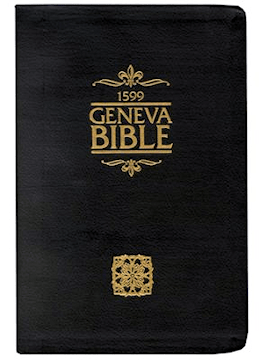Textus Receptus Bibles
Geneva Bible 1560/1599
| 6:1 | Againe, I turned and lift vp mine eyes, and looked: and beholde, there came foure charets out from betweene two mountaines, and the mountaines were mountaines of brasse. |
| 6:2 | In the first charet were red horses, and in the second charet blacke horses, |
| 6:3 | And in the thirde charet white horses, and in the fourth charet, horses of diuers colours, and reddish. |
| 6:4 | Then I answered, and saide vnto the Angell that talked with mee, What are these, my Lord? |
| 6:5 | And the Angell answered, and sayde vnto mee, These are the foure spirites of the heauen, which goe foorth from standing with the Lord of all the earth. |
| 6:6 | That with the blacke horse went forth into the land of the North, and the white went out after them, and they of diuers colours went forth toward the South countrey. |
| 6:7 | And the reddish went out, and required to go, and passe through the world, and he sayde, Goe passe through the worlde. So they went thorowout the world. |
| 6:8 | Then cryed hee vpon me, and spake vnto me, saying, Beholde, these that goe towarde the North countrey, haue pacified my spirit in the North countrey. |
| 6:9 | And the worde of the Lord came vnto me, saying, |
| 6:10 | Take of them of ye captiuitie, euen of Heldai, and of Tobijah, and Iedaiah, which are come from Babel, and come thou the same day, and goe vnto the house of Ioshiah, the sonne of Zephaniah. |
| 6:11 | Take euen siluer, and golde, and make crownes, and set them vpon the head of Iehoshua, the sonne of Iehozadak the hie Priest, |
| 6:12 | And speake vnto him, saying, Thus speaketh the Lord of hostes, and sayth, Behold the man whose name is the Branch, and he shall growe vp out of his place, and he shall build the Temple of the Lord. |
| 6:13 | Euen hee shall build the Temple of the Lord, and he shall beare the glory, and shall sit and rule vpon his throne, and he shalbe a Priest vpon his throne, and the counsell of peace shall be betweene them both. |
| 6:14 | And the crownes shall be to Helem, and to Tobijah, and to Iedaiah, and to Hen the sonne of Zephaniah, for a memoriall in the Temple of the Lord. |
| 6:15 | And they that are farre off, shall come and build in the Temple of the Lord, and ye shall know, that the Lord of hostes hath sent me vnto you. And this shall come to passe, if ye will obey the voyce of the Lord your God. |

Geneva Bible 1560/1599
The Geneva Bible is one of the most influential and historically significant translations of the Bible into English, preceding the King James translation by 51 years. It was the primary Bible of 16th century Protestantism and was the Bible used by William Shakespeare, Oliver Cromwell, John Knox, John Donne, and John Bunyan. The language of the Geneva Bible was more forceful and vigorous and because of this, most readers strongly preferred this version at the time.
The Geneva Bible was produced by a group of English scholars who, fleeing from the reign of Queen Mary, had found refuge in Switzerland. During the reign of Queen Mary, no Bibles were printed in England, the English Bible was no longer used in churches and English Bibles already in churches were removed and burned. Mary was determined to return Britain to Roman Catholicism.
The first English Protestant to die during Mary's turbulent reign was John Rogers in 1555, who had been the editor of the Matthews Bible. At this time, hundreds of Protestants left England and headed for Geneva, a city which under the leadership of Calvin, had become the intellectual and spiritual capital of European Protestants.
One of these exiles was William Whittingham, a fellow of Christ Church at Oxford University, who had been a diplomat, a courtier, was much traveled and skilled in many languages including Greek and Hebrew. He eventually succeeded John Knox as the minister of the English congregation in Geneva. Whittingham went on to publish the 1560 Geneva Bible.
This version is significant because, it came with a variety of scriptural study guides and aids, which included verse citations that allow the reader to cross-reference one verse with numerous relevant verses in the rest of the Bible, introductions to each book of the Bible that acted to summarize all of the material that each book would cover, maps, tables, woodcut illustrations, indices, as well as other included features, all of which would eventually lead to the reputation of the Geneva Bible as history's very first study Bible.